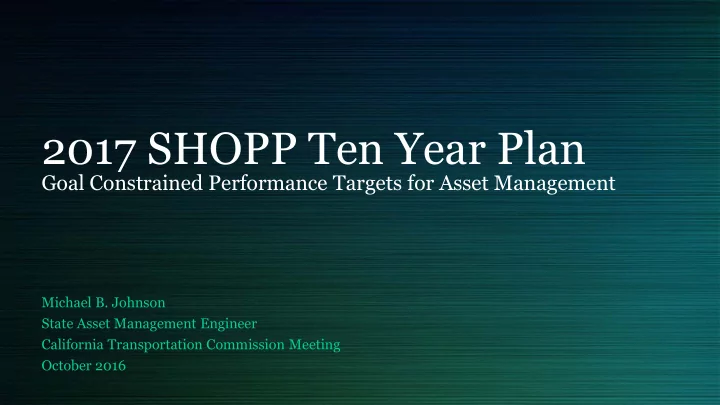

2017 SHOPP Ten Year Plan Goal Constrained Performance Targets for A sset Management Michael B. Johnson State Asset Management Engineer California Transportation Commission Meeting October 2016
Background • California Streets and Highway Code (164.6) requires Caltrans to prepare a Ten Year Plan for the SHOPP and submit to the CTC in January 2017. • Federal Regulation (MAP-21/FAST Act) requires the development of a Transportation Asset Management Plan (TAMP) with National Performance Measures for pavement and bridges. • The TAMP Requires the implementation of Performance Management which requires performance targets to be set using the National Measures. • Government Code requires a “robust asset management plan” with performance measures and targets approved by the CTC. Consistent with Federal Law. • The 2017 SHOPP Ten Year Plan will implement Performance Management in the SHOPP with National Measures for pavements and bridges. • CTC approval of performance targets prior to January 2017 necessary to build the 2017 Ten Year Plan.
Commission's Prior Asset Management Approvals • Adopt Good, Fair, Poor performance measures reflecting state goals and objectives • Completed March 2015 • Define “focus areas” for Phase 1 of the Transportation Asset Management Plan • Pavement, bridges, culverts and ITS Elements • Completed in March 2015 with the adoption of the four asset classes • Approve the framework of the Phase 1 Transportation Asset Management Plan • Completed in March 2016
Goal Constrained Target Purpose • Streets and Highway Code requires that “all rehabilitation needs” be included in the Ten Year Plan. This requires the setting of the upper bound (goal constrained) • MAP-21/FAST requires targets to establish bounds for a performance gap analysis necessary for asset management. Increasing Cost Goal Constrained Target (Upper Bound) Current Levels (Along Curve) Do Nothing Alternative Performance Gap (Lower Bound) Improving Condition /Performance
Measuring Asset Condition - - Full listing of criteria for the four asset classes is included as an attachment to the book item.
Performance Measure Scales – It’s The Same Banana Inventory Needing Work Legacy Good Major Maintenance Distressed/Poor MAP-21 Good Fair Poor Inventory Needing Work
Target Setting Criteria • General – Targets consider deterioration rate, rate of inventory growth, long term costs, consequence of inaction (risks) and practical project delivery time frames. • Poor Targets • We would like a zero poor target, but this is not achievable. • Therefore targets are set at the practical minimum percentage given the factors noted above. • Fair Targets • Performance-cost curves developed to understand the relationship of these factors • Target evaluation considered existing conditions, rate of needs identification, performance-cost curves, deterioration rates and typical delivery timeframes to establish the recommended target condition level.
Pavement Classes Class 1 Routes – Red Lines Class 2 Routes – Blue Lines Class 3 Routes – Green Lines
Recommended Performance Targets Estimated MAP -21 Good MAP-21 Fair MAP-21 Poor Annual Costs Current Target Current Target Current Target (Billions) Pavement (Class 1) 45% 60% 51% 39% 4% 1% 1.25 Pavement (Class 2) 35% 55% 58% 43% 7% 2% 0.49 Pavement (Class 3) 38% 45% 54% 53% 8% 2% 0.12 • Pavement area separated into classes to allow for tailoring of investment by use characteristics • Class 1 routes are the busiest routes in the system and include all interstates, all principle arterial routes and urban freeways and expressways. • Class 2 routes include rural freeways and expressways and minor arterials. • Class 3 routes include major and minor collector routes.
Cost Performance Curve - Example
Recommended Performance Targets Asset Class MAP -21 Good MAP-21 Fair MAP-21 Poor Estimated SHOPP Annual Cost Current Target Current Target Current Target (Billions) Bridge Condition 75% 83.5% 21.7% 15% 3.3% 1.5% $ 0.548 Culvert Condition 65% 80% 23.5% 10% 11.5% 10% $ 0.261 ITS Element Health 64.5% 90% NA NA 35.5% 10% $ 0.194
Next Steps • Use the performance targets to develop the 2017 SHOPP Ten Year Plan needs • Deliver the 2017 Ten Year Plan to the Commission in January 2017 • The 2017 Ten Year Plan will define the total goal constrained SHOPP need and recommended an investment plan for the available SHOPP funds • The 2017 Ten Year Plan will fully implement the Performance Management requirements of MAP-21 • The 2017 Ten Year Plan will guide future planning and SHOPP programming • Monitoring of performance relative to targets
Thank You
Recommend
More recommend